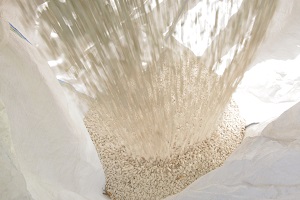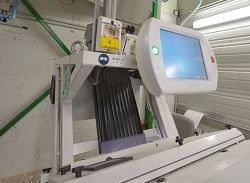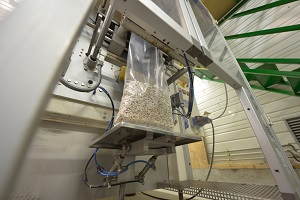The reception
raw white beans
It is the producers themselves who come, in turn, to deliver their harvest to the Cooperative located in Tarbes.
Each container (usually big bags) is weighed and a sample is taken to measure the moisture of the beans.
A traceability tag is then created to identify each big-bag.
It includes the following: identification of producer, plot and guardian, delivery date, weight and humidity.


Ventilation
The first step is ventilation through a cascade box: the heavy elements (white beans) fall while the light elements are sucked and separated from the beans. This eliminates some of the pods, dust, broken ...
A moisture control is performed during this step to verify the need or not to proceed with the drying of the batch.
The traceability label is updated with this new information: ventilated weight and humidity.
Additional drying
If the humidity of the big-bag is greater than 17%, the Cooperative is then dried in a thermostatically ventilated and thermostatically controlled gas oven. It is composed of 8 wooden boxes. The drying temperature is limited to 30 ° C maximum.
After checking the final humidity of each box, the white beans are put back in big-bag and the traceability label is updated once again with the weight after drying and the final moisture.
As soon as the whole lot (a producer, a plot and a tutor) is ventilated and dry, it is ready to be sorted by the technical department .
It will be stored first before being transferred to the Cooperative's triage shop.
CALIBRATION
The grains then pass into an optical sorter.
The calibrated beans advance in single file at high speed, through a vibrator on a plate inclined at 45 ° with 24 channels, and pass in front of 2 camera blocks that will analyze them in front and behind. If the cameras detect a color defect, a compressed air ejection system expels stained grain from the circuit.
In order to guarantee optimum quality, batches generally pass twice to the optical sorter.
This sorting is completed by the passage of white beans on a magnet capturing the possible metal elements that may be present.


COLORIMETRIC TRI
The grains then pass into an optical sorter.
The calibrated beans advance in single file at high speed, through a vibrator on a plate inclined at 45 ° with 24 channels, and pass in front of 2 camera blocks that will analyze them in front and behind. If the cameras detect a color defect, a compressed air ejection system expels stained grain from the circuit.
In order to guarantee optimum quality, batches generally pass twice to the optical sorter.
This sorting is completed by the passage of white beans on a magnet capturing the possible metal elements that may be present.
The grading
During the entire triage operation, the authorized technicians of the Cooperative carry out batch quality control operations. Grain size, appearance defects, cleanliness ... everything is observed. All the approval results are recorded on the batch approval form, which also includes all the traceability information of the batch since it was received at the workshop. This is the "identity card" of our product!
WEIGHING-PACKING
Once the batch is approved, the beans will be weighed by an associative weigher and put in pocket thanks to a vertical bagging machine. The set of batches is packaged in a first time pocket 5 kg necessary to achieve the next heat treatment.
One last check to ensure you a quality product:
All the pockets then pass under an X-ray detector which ejects any packaging containing a foreign body and in particular the pebbles potentially present.
The pockets are then opened and the foreign body removed to be able to return the beans.

Heat treatment
All the production is treated thanks to a thermal shock by the cold, in the strict respect of a ratio time / temperature, in order to eradicate any risk of development of the weevils, main pest of the dry vegetables.
After the heat treatment, our white beans can be called Tarbais beans. It is of course allowed to return quietly to room temperature and it is ready to be marketed in Occitania of course but also everywhere in France and in the world!
Reconditioning
The Cooperative's workshop is also used to package Tarbais beans in 1 kg, 500 g and 250 g bags. The technical department then opens the 5 kg bags and the Tarbes Beans are then weighed, bagged and ironed at the x-ray detector. They keep their initial batch number.
Waste treatment
All of the cooperative's waste is sorted by category in order to be recycled at best and limit the impact of our structure on the environment.
Today, plant waste from ventilation and sorting is used in animal feed.









